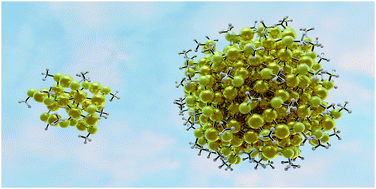Structure–property relationships on thiolate-protected gold nanoclusters†
Abstract
Since their discovery, thiolate-protected gold nanoclusters (Aun(SR)m) have garnered a lot of interest due to their fascinating properties and “magic-number” stability. However, models describing the thermodynamic stability and electronic properties of these nanostructures as a function of their size are missing in the literature. Herein, we employ first principles calculations to rationalize the stability of fifteen experimentally determined gold nanoclusters in conjunction with a recently developed thermodynamic stability theory on small Au nanoclusters (≤102 Au atoms). Our results demonstrate that the thermodynamic stability theory can capture the stability of large, atomically precise nanoclusters, Au279(SR)84, Au246(SR)80, and Au146(SR)57, suggesting its applicability over larger cluster size regimes than its original development. Importantly, we develop structure–property relationships on Au nanoclusters, connecting their ionization potential and electron affinity to the number of gold atoms within the nanocluster. Altogether, a computational scheme is described that can aid experimental efforts towards a property-specific, targeted synthesis of gold nanoclusters.



 Please wait while we load your content...
Please wait while we load your content...